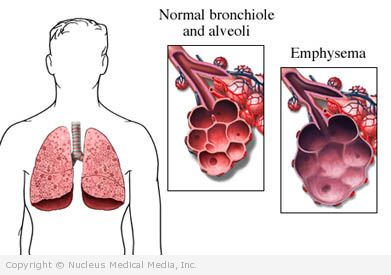Chronic obstructive pulmonary disease – COPD
Chronic obstructive pulmonary disease – Definition
Chronic obstructive pulmonary disease (COPD) is a long term lung disease. COPD makes it difficult to move air in and out of the lungs. It will make breathing difficult. COPD includes:
- Emphysema — air sacs of lungs are damaged
- Chronic bronchitis — airways of lungs are damaged
The changes to lung tissue differ with the two diseases. However, they often occur together. The causes and treatment of each conditions are similar.
Chronic obstructive pulmonary disease – Causes
COPD is caused by damage to the lungs. This damage is caused by:
- Cigarette smoking
- Inhaling toxins or other irritants
- Genetic predisposition that makes the lungs more vulnerable to damage from smoke or pollutants (includes alpha-1-antitrypsin deficiency)
Chronic obstructive pulmonary disease – Risk Factors
Factors that increase your chance of developing COPD include:
- Smoking cigarettes
- Long-term exposure to second-hand or passive smoke
- Family members with COPD
- Exposure to pollutants
- History of frequent childhood lung infections
- Age: 40 years or older
Chronic obstructive pulmonary disease – Symptoms
Early symptoms of COPD include:
- Coughing
- Increased sputum production (mucus from deep in the lungs)
- Wheezing
- Shortness of breath with activity
As the disease progresses, symptoms may include:
- Increased shortness of breath
- Choking sensation when lying flat
- Fatigue
- Trouble concentrating
- Heart problems
- Weight loss
- Breathing through pursed lips
- Desire to lean forward to improve breathing
- More frequent flare-ups (periods of more severe symptoms)
Chronic obstructive pulmonary disease – Diagnosis
The doctor will ask about your symptoms and medical history. A physical exam will be done.
Your doctor will need to test how impaired your lungs may be. This may be done with:
- Lung function tests (spirometry) — to test the force of your breath
- Blood test — to test oxygen and carbon dioxide levels in the blood
Your doctor may also need detailed pictures of your lungs. This may be done with:
- Chest x-ray
- CT scan
Chronic obstructive pulmonary disease – Treatment
There is no treatment to cure COPD. Treatment aims to ease symptoms and improve quality of life.
Treatment includes:
Smoking Cessation
Quitting smoking slows the disease. It the most important part of treatment. There are many programs to help you quit including:
- Behavior change progam
- Medication
- Combination of behavior program and medication
Environmental Management
Limit the number of irritants in the air you breathe. It may help make breathing easier. Avoid smoke, dust, smog, extreme heat or cold, and high altitudes.
Medication
Medication for COPD may help by:
- Opening the airways
- Relaxing the breathing passages
- Decreasing inflammation
- Treating lung infections (antibiotics)
Some medication may be taken as pills or liquids. Others are inhaled medication that is delivered directly to the lungs.
Vaccines
The flu and pneumonia can make your symptoms worse. Get vaccinated against pneumonia and the flu. The flu vaccine may also reduce COPD flare-ups.
Oxygen
Oxygen therapy may be helpful if the oxygen levesl in your blood are too low. It can relieve trouble breathing and improve energy. You may only need it for specific activities or it may be given throughout the day.
Exercise
Special exercises can strengthen chest muscles. This can make it easier to breathe.
Regular physical activity can reduce the workload on your lungs by building you endurance. Physical acitivty is also associated with improved quality of life. Follow your doctor’s recommendations for activity levels and restrictions.
Breathing and Coughing Techniques
Special methods of breathing can help bring more air into the lungs. It can also help force trapped air out of the lungs. Effective coughing techniques can also help clear mucus from your lungs. Ask your doctor if these techniques can help you. Some examples include:
- Pursed lip breathing
- Controlled coughing technique
Nutrition
Eating habits to consider with COPD:
- Eat a healthy diet. It should be low in saturated fat. It should also be rich in fruits, vegetables, and whole grain foods.
- Maintain a normal weight. Excess weight causes the lungs and heart to work harder.
- It may be hard to eat because you feel full. Try eating several smaller meals during the day instead of a few large meals.
- Slow down your eating pace. This will make it easier to breathe
- If you need to gain weight, add food or drinks throughout the day. Talk to a dietitian about how many calories you need each day.
Lifestyle Changes
The following may help you manage COPD symptoms and avoid flare-ups:
- Pace your activities.
- Learn relaxation techniques and other methods to manage stress.
- Seek emotional support from professionals, family, and friends. Anxiety can increase the rate of respiration, making breathing more strenuous.
Surgery
A small number of patients may benefit from surgery. Suregery options include removing a part of the lung or a lung transplant.
Chronic obstructive pulmonary disease – Prevention
Take these steps to reduce your chance of developing COPD:
- If you smoke, quit.
- Avoid exposure to second-hand smoke.
- Avoid exposure to air pollution or irritants.
- Wear protective gear if exposed to irritants or toxins at work.

